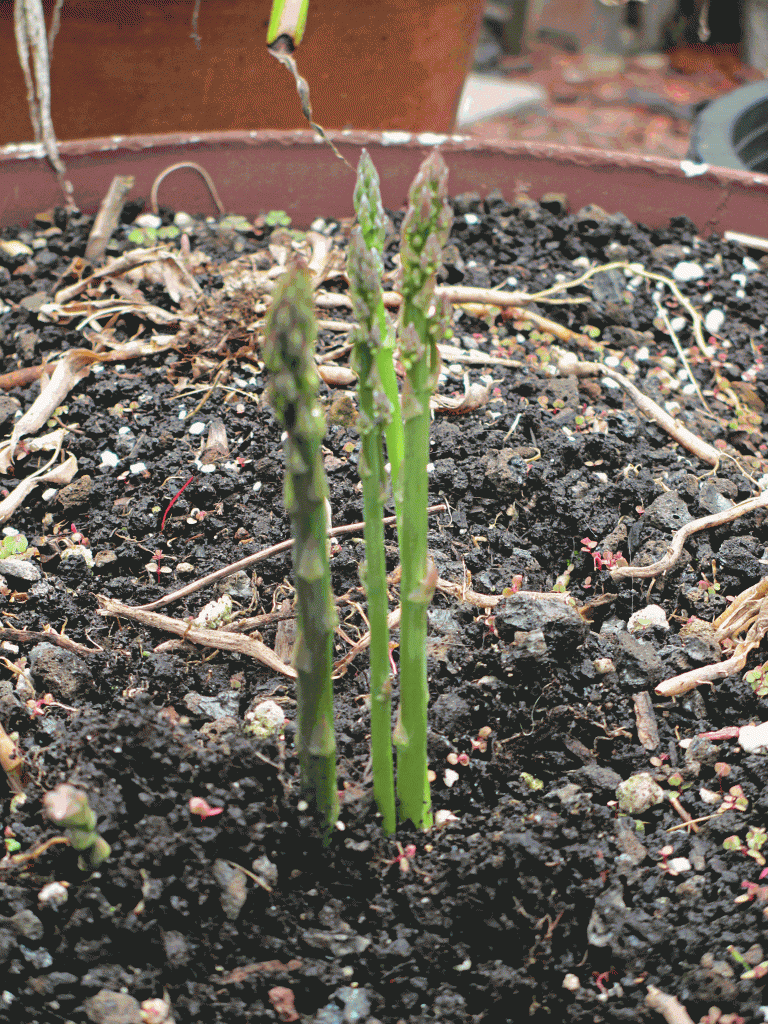Asparagus: Hard to Start, Easy to Grow

Newly sprouted asparagus in the author’s garden. PC: J.M. Buck
Asparagus is delicious, grows well in just about any Hawaiian region, and is even easier to prepare in the kitchen.
Endemic to Asia Minor and the eastern Mediterranean, growing techniques for asparagus (Asparagus officinalis) were recorded by Cato as far back as 200 BCE. A relative of leeks, onions and garlic, it was the Greeks that first cultivated this Mediterranean favorite and dubbed it “asparagos.” The ancient Egyptians were known to have appreciated it, and this member of the lily family became an early Roman favorite to the point that emperors assigned a special sailing fleet to import the vegetable.
Asparagus was highly prized in Italy, with the spears conveying grace and elegance. In fact, asparagus was tremendously expensive in Italy way back when, and, comparatively speaking, was considered a delicacy that only the wealthiest could afford.
Asparagus made its way across Europe over a twelve-century span, appearing in England approximately 1,000 years ago and in France in the mid-to-late 1500s. From there it was brought to North America.
Asparagus enjoys a sunny location with loose, well-drained soil. It’s not a finicky plant after it is established, and given proper aeration, will do well even in clay soil. It can also grow well in moderately salty near-shore environments and saline or brackish conditions.
The plant does best in slightly alkaline soil with a pH of between 6.7 and 7.5. Acidic soil below 6.0 is too harsh for asparagus.
One note: Asparagus is not vog tolerant. If you live in an area subject to voggy conditions or receives frequent acid rain, you will want to grow asparagus under the protection of greenhouse plastic.
One of the rewards of growing asparagus is that it is a perennial and will produce spears for up to 16 or 20 years. It is best planted along a wall or fence line, or at the rear of your garden to serve as a decorative backdrop to your other garden plants. You will want to allow plenty of growth room for asparagus as the plants grow three to four feet tall with spreading, lacy foliage.
The most popular method for starting asparagus is from seed. You can also start them by obtaining 1-year-old root “crowns” which can be difficult to find. I found some nice root crowns at Paradise Plants in Hilo. Depending on how prolific you would like your yield to be, you will want to choose your cultivar carefully. Flowering and seeding varieties such as “Mary Washington” produce fewer spears than the popular all-male varieties, of which there are several to choose from. All-male varieties do not produce flowers or seeds, however their spear yield is superior. According to the UH Manoa College of Tropical Agriculture and Human Resources (CTAHR), Apollo, Atlas, and UC 157 all do well in our climes.
To plant an asparagus row, dig a trench 18-inches wide and 18-inches deep. Space plants one foot apart. If you desire more than one row, allow four feet between rows.
Amend the soil you dug out of the trench with dolomite lime to bring up the pH, and go heavy on the compost and well-rotted chicken or steer manure. Asparagus likes phosphorus, so add an organic 0-46-0 fertilizer to the bottom of the trench, or dust the bottom with rock powder and a an extremely light dusting of a natural detergent like Earth Save laundry soap. Seriously–it works! Adding phosphorus in this manner prior to planting will help increase your yield.
Cover the fertilizer with 6 to 8 inches of amended soil and plant your seedlings, making sure not to bury any of the foliage. Do not fill the trench! Water well, keeping the soil slightly moist but not wet. Gradually fill in the trench as spear tips begin to shoot up, taking care not to cover any foliage or tips. On the average, filling the trench as growth occurs will take 4 to 6 weeks.
Developing an established, deep root mass during the first year will ensure hardy plants and good production in the future. Providing ample deep watering (2 to 3 inches every other week) with a slow-watering process such as drip irrigation or soaker hose is key during the first year. Also, asparagus is intolerant of weeds that rob nutrients, so take care to pull pesky vegetation on a regular basis.
To harvest, withhold water for one month. When the ferns die back, cut them down to the ground. Apply an organic 10-30-10 fertilizer, four inches of compost, and water deeply. When the new shoots spring up, cut them off at the base of the root ball just below ground level. Continue harvesting the new shoots for five to six weeks. If you would like asparagus year-round, stagger this process with your plants.
Harvested asparagus spears perish rapidly; right after harvesting plunge the spears into ice water for a few seconds and store in the crisper drawer of your refrigerator. They should be eaten as soon as possible for best flavor.
Happy gardening!













